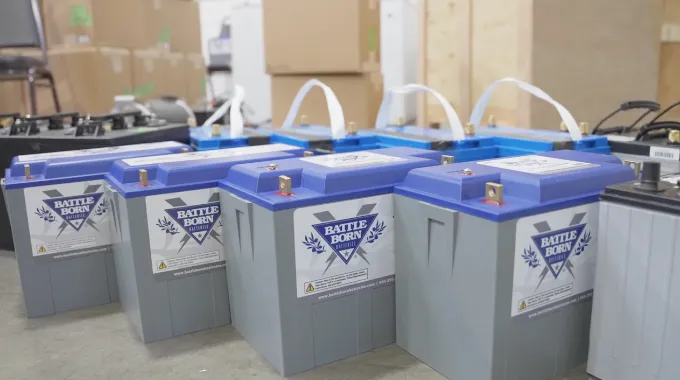Last Updated on September 21, 2023
Embarking on the open road in your RV, powered by the sun’s energy, offers an unrivaled sense of freedom and sustainability. As the popularity of RV solar systems continues to rise, energy storage solutions are becoming increasingly popular.
So, you’re thinking about combining different batteries in your RV solar system. You can mix and match batteries for your RV solar system, but you need to choose the right type that is compatible with your existing setup.
Having the correct combination of batteries and connecting them correctly can help you get maximum power output for your RV solar system.
Here, we’ll discuss the pros and cons, whether combining a traditional car with a solar battery is possible, and more.
How Can You Combine Different Batteries in Your RV Solar System?
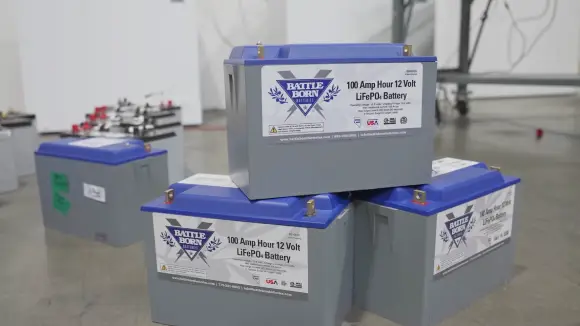
There are several key points to consider when combining different batteries in your RV solar system. Here is a step-by-step guide to combining and mixing different batteries in your RV solar system:
- Step 1: Understand battery types
- Lead-Acid Batteries
- Lithium Batteries
- Step 2: Assess battery conditions
- Step 3: Calculate battery capacity
- Step 4: Wiring configuration
- Parallel configuration
- Series configuration
- Step 5: Ensure balanced charging and discharging
- Step 6: Properly size cables and fuses
Let’s take a closer look at each of these steps.
Step 1: Understand Battery Types
To prevent imbalances in your charging and discharging rates, combining batteries of the same type in your RV solar system is generally recommended.
Different battery types, such as lead-acid (flooded, AGM, gel) and lithium-ion, have unique characteristics that affect their performance.
1. Lead-Acid Batteries
Flooded Lead-Acid: These traditional batteries require periodic maintenance to refill water levels and are commonly used in RVs.
Absorbent Glass Mat (AGM) Lead-Acid: Maintenance-free and more efficient than flooded batteries, AGM batteries are spill-proof and offer better performance.
Gel Lead-Acid: Gel batteries are also maintenance-free and are known for their resistance to deep discharges and vibration.
2. Lithium Batteries
Lithium Iron Phosphate (LiFePO4): Highly durable and with a longer lifespan, LiFePO4 batteries offer consistent performance and a wide depth of discharge.
Lithium-ion (Li-ion): Li-ion batteries are known for their high energy density, lightweight design, and relatively longer lifespan compared to lead-acid batteries.
Step 2: Assess Battery Conditions
Next, check your batteries’ voltage levels and conditions to ensure they are compatible and will not cause any damage.
It is crucial to assess the state of your batteries before combining them in an RV solar system. Start by examining the voltage levels of each battery. Make sure that they have similar voltage readings to avoid imbalanced charging.
Additionally, consider the overall condition of the batteries. Ensure that they are in good health and have a similar usage history. Combining batteries with vastly different states of charge or conditions can lead to problems such as reduced performance and shortened battery life.
Step 3: Calculate Battery Capacity
You can calculate each battery’s capacity by dividing the total watt-hours of energy needed for your RV solar system by the voltage of each battery. This will estimate how much power each battery can store and provide to the overall system.
For example, if you need a total of 500 watt-hours of energy for your RV and each battery is 12 volts, then the capacity of each battery would be 42 amp-hours.
Step 4: Wiring Configuration
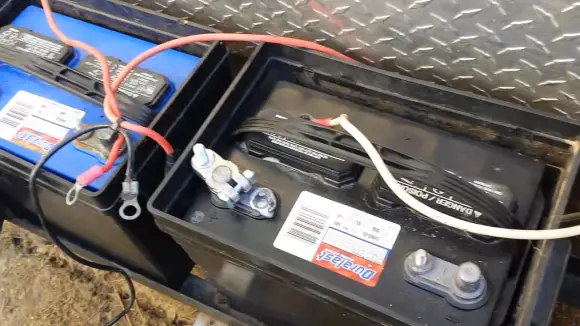
1. Parallel Configuration
To combine different batteries in your RV solar system, simply connect the positive and negative terminals. This parallel configuration allows you to increase the overall capacity of your system while maintaining the voltage.
By connecting the positive terminals, you are effectively adding the amp-hour ratings of the batteries together. Similarly, connecting the negative terminals ensures that the voltage remains consistent across all batteries.
This setup is ideal for maximizing the power output of your solar system.
2. Series Configuration
By connecting one battery’s positive terminal to the next’s negative terminal, you can increase the voltage in a series configuration. This method is commonly used in RV solar systems to achieve higher voltage levels for efficient power generation.
When batteries are connected in series, the voltages of each battery are added together. This allows for a larger overall voltage output, which is beneficial for powering various appliances and devices in your RV.
Step 5: Ensure Balanced Charging and Discharging
It’s important to use a solar battery monitor or BMS to ensure all batteries receive equal treatment in terms of balanced charging and discharging. This is particularly crucial when combining different batteries in an RV solar system.
A solar battery monitor or BMS can monitor and control each battery’s charge state, preventing overcharging or over-discharging of individual batteries. This helps maintain the overall health and longevity of the battery bank.
By ensuring balanced charging and discharging, you can maximize the efficiency and performance of your RV solar system.
Additionally, a solar battery monitor or BMS provides valuable real-time data on battery status, allowing you to make informed decisions and optimize your power usage.
So, invest in a reliable solar battery monitor or BMS to protect your batteries and optimize your RV solar system’s performance.
Step 6: Properly Size Cables and Fuses
Ensure you use appropriately sized cables and install fuses or circuit breakers to ensure the safety and efficiency of your electrical system in the RV.
Using too small cables can result in voltage drop, which reduces the effectiveness of your solar system. Additionally, oversized cables can generate excess heat and pose a fire hazard. Therefore, it is essential to select cables that are properly sized for the current and length of the circuit.
Furthermore, installing fuses or circuit breakers will protect your wiring and batteries from overloads, preventing damage and potential accidents.
Pros and Cons of Combining Different Batteries in RV Solar System
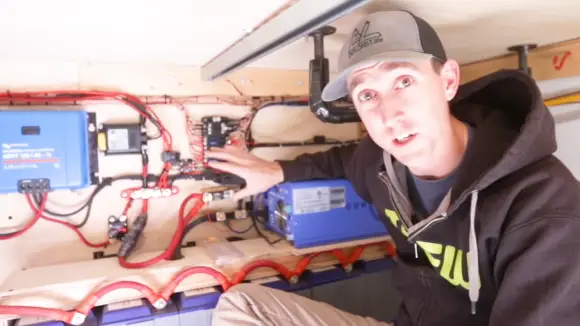
When it comes to combining different batteries in your RV solar system, there are both pros and cons to consider.
Pros
Combining different batteries can offer several advantages when optimizing energy storage in your RV solar system.
1. Optimized Energy Storage
You can achieve optimized energy storage in your RV solar system by combining different types of batteries. By utilizing the strengths of each battery type, you can create a setup that maximizes efficiency and meets your specific energy needs.
For instance, pairing lithium batteries with lead-acid batteries allows you to benefit from lithium’s high energy density and rapid charging/discharging capabilities. This combination provides a reliable power source that can handle high energy demands.
2. Cost Efficiency
Mixing various types of solar batteries can be a more cost-effective solution. You can benefit from both advantages by combining lead-acid and lithium batteries in your RV solar system.
Lithium batteries offer longer lifespans and better performance, while lead-acid batteries are more budget-friendly. This hybrid approach allows you to optimize energy storage while minimizing costs, making it an efficient choice for your RV solar setup.
3. Increased Energy Capacity
You can significantly increase your energy storage capacity by combining batteries with varying capacities in your RV solar system.
This means you’ll be able to store more energy from your solar panels and have a greater reserve for use during cloudy days or at night.
A higher overall energy capacity is particularly advantageous for RV owners, as it ensures a reliable and consistent power supply for all your electrical needs.
4. Balanced Charging and Discharging
By combining batteries in an RV solar system, you can achieve a more balanced charging and discharging cycle, which can help extend the lifespan of your battery bank. This balance ensures that each battery is charged and discharged evenly, preventing overcharging or undercharging of any individual battery.
5. Redundancy and Reliability
Having multiple solar batteries in your RV ensures greater reliability for your energy system. If one battery fails, you still have others to rely on, preventing a complete power outage during your trips.
By combining different batteries in your RV solar system, you can optimize your energy storage capacity and increase the overall efficiency of your system. It allows for better battery workload distribution, ensuring a longer lifespan and enhanced performance.
6. Improved Performance
Mixing lithium and lead-acid batteries in your RV solar setup can significantly improve performance. By combining these two types of batteries, you can benefit from the quick energy access provided by lithium batteries and the extended energy storage offered by lead-acid batteries.
This combination allows for a more efficient and reliable power supply, ensuring that your RV solar system can meet your energy needs effectively.
Cons
When considering the cons of combining different batteries in an RV solar system, there are several key points to be aware of.
1. Complex Battery Management
You should be aware that managing multiple battery chemistries in your RV solar system can be complex. It may require additional equipment to ensure optimal performance and prevent overcharging or undercharging.
Different battery types have different charging and discharging profiles, requiring specific monitoring and control mechanisms. Without proper management, you risk damaging the batteries and reducing their overall lifespan.
To avoid these issues, it is crucial to invest in the necessary equipment and expertise to manage your RV solar system’s battery chemistries effectively.
2. Different Lifespan
You should note that lithium batteries generally last longer than lead-acid batteries. When combining different battery types in an RV solar system, their varying lifespans can become a significant factor.
3. Compatibility Challenges
Using incompatible solar battery types may require additional hardware to ensure proper operation.
When combining different batteries in an RV solar system, compatibility challenges can arise due to differences in voltage, capacity, and charging requirements. These disparities can lead to inefficient charging, reduced battery life, and potential damage to the system.
To overcome these challenges, it is crucial to use DC-DC converters or other necessary equipment to harmonize the different battery types and optimize their performance in the solar system.
4. Increased Weight and Space
Combining different solar battery types in your RV solar system can increase weight and space requirements. This can pose a challenge as it may exceed your RV’s weight limits and reduce available storage.
It’s important to consider the size and weight of each battery before combining them. The added weight and space can impact your RV’s overall performance and functionality, so it’s crucial to evaluate compatibility and prioritize efficiency carefully.
5. Maintenance Complexity
Different battery chemistries require specific charging and maintenance procedures to ensure optimal performance and longevity.
For example, lead-acid batteries need regular electrolyte checks and occasional water refills, while lithium-ion batteries require precise voltage and temperature monitoring.
Understanding and meeting these individual requirements is crucial to effectively manage a mixed battery bank in an RV solar system.
Can I combine a traditional car battery with a solar battery in my RV setup?
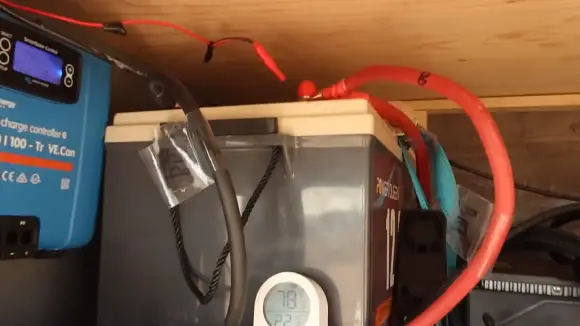
Mixing a car battery and a solar battery in an RV setup is generally not recommended. Solar batteries are designed for frequent deep discharges, while car batteries are optimized for shallow discharges and starting power.
When these batteries are combined, they may experience an imbalance in charging and discharging. This can lead to reduced overall performance and a shorter lifespan for both batteries.
In addition, car batteries are not typically built to withstand the demands of a solar system. This can result in premature failure or damage to the battery. To ensure optimal performance and longevity, it is advisable to use batteries that are specifically designed for solar applications in your RV setup.
Can I use the same solar charge controller for different battery types?
If you’re considering using different battery types in your RV solar system, it depends on the compatibility of the charge controller with various battery chemistries.
Some advanced controllers offer configurable settings that allow you to adjust the charging parameters for different battery types. However, not all controllers have this feature, and in such cases, you may need to replace the controller to accommodate specific battery types.
Choosing a charge controller that supports the battery chemistry you plan to use in your RV solar system is important. This ensures that the batteries are charged optimally and prolongs their lifespan.
Combine Different Batteries: Maximize RV Solar Power
Combining different batteries in your RV solar system can be both advantageous and disadvantageous.
On one hand, it allows you to utilize various battery types, maximizing your energy storage capacity. It can also lead to inefficiencies and potential damage if not done properly.
When combining batteries, it is crucial to consider factors such as battery capacity, voltage compatibility, and charging methods. If you plan on using different battery types, ensure your charge controller is compatible. Additionally, consider a good monitoring system to help maximize efficiency and protect your batteries from damage.
With the right setup, you can reap the benefits of having a multi-battery RV solar system without sacrificing performance or longevity.

